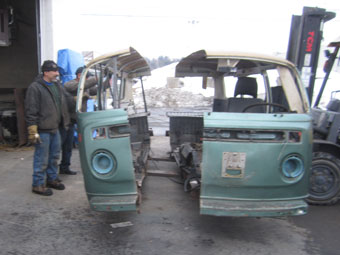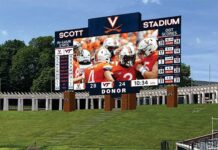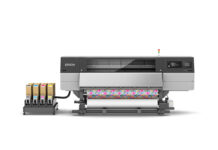In early 2014, Tom Walsh, owner of Sign Language, a manufacturing sign shop in Poughkeepsie, New York, was just about through installing signs for the food court at the Empire City Casino at Yonkers Raceway when he was presented with a unique challenge.
“The owner of the casino told the company that had hired me, Goldman Design Group, that he would like a vehicle installed on the outside of the building, facing the racetrack,” he says. “They asked if I could come up with something like a Volkswagen bus.”
Walsh’s initial reaction was to let someone else assume this job.
“When they first told me what they wanted to do, it seemed way too much to take on,” he admits.
But as he thought the project through, Walsh realized he could pull it off—with the right help. “What finally convinced me was that I thought it would be something interesting to do,” he says, “if I could get someone to do the body work.”
Sign and Service Window
The goal was to install the vehicle at the front of the casino’s food court, facing a walkway leading to the adjacent Yonker’s Raceway. It would serve two purposes: (1.) as a sign announcing theLil’ Cocina Mexican restaurant and its menu, and (2.) as the service counter where customers could step up, place orders, and receive their food.
Walsh has years of experience designing and installing signs on all types of buildings—inside and out. The challenge for him here was reworking a vintage vehicle into a workable sign with the support framework to match up with the building’s exterior as a food service counter.
Walsh consulted with Joe Quitoni, owner of Joe Que’s Auto Body in Poughkeepsie. “We’ve done things like this before and know how to go about it,” says Quitoni, noting that, on several past projects, he’d installed portions of cars on billboards promoting collision centers.
“[Joe] and I hashed out the project and some numbers and figured out how we could do this one,” says Walsh. “I’d focus on the sign aspects, while he would take care of the body work and structural support.”

A Vintage VW
Once they agreed that this custom sign request was feasible, they had to find the best vehicle for the project.
After evaluating images of vintage Volkswagen buses online, Walsh decided the 1971 model would be the best fit. “I really like the body lines on the 1971 VW bus and thought it would work well,” he says.
He submitted a photo of the model and awaited approval from the casino owner. As soon as that came, Quitoni searched area salvage yards and found a usable bus rusting in the snow.
The van had sustained driver’s side damage in an accident, but the passenger’s side (needed so the front of the bus would point toward the racetrack) was largely intact. They purchased the body and brought the vehicle to Walsh’s shop for phase one of the project: reducing the mini-bus to a workable profile of its exterior.
They had calculated they needed the bus to be twenty inches deep along its entire length. Once the interior of the bus was completely gutted, steel bracing was welded in place (from front to rear and floor to ceiling) before the side doors could be dismantled. “We had to make sure nothing would move once we started cutting,” explains Quitoni.
The body was cut to size using a combination of a sawzall twelve-inch grinding wheel and a plasma cutter around the suspension system. Then the focus turned to the body. “This was like a complete restoration project, but we only worked on half a car,” notes Quitoni.
New quarter panels were installed, the wheel wells completely rebuilt, and new steel added to conceal the VW bus’s gas tank spout.
Trial Run
Once the restoration work was complete, the body primed, and all the support framework in place, it was moved to the site for a test installation.
“[Quitoni] had already figured how he was going to attach it to the building,” notes Walsh. “We wanted to make sure everything would line up correctly.”
Slight modifications had to be made to match up with the window planned for the wall separating the restaurant from the sidewalk. “We had to move some of the braces down a couple of inches to make way for the countertop for the serving window,” says Quitoni.
At his shop, Quitoni fabricated and welded steel clamps in place, which would be used to bolt the body to the building. The van was painted yellow and orange to match the color theme of the food court’s interior and signage.
Walsh designed and installed a vehicle wrap along the lower section of the body and doors with a combination of graphics and logo announcing the “Lil’ Cocina.” The wrap was printed on 3M™ Controltac™ Graphic Film Series 180 vinyl with his sixty-four-inch Seiko ColorPainter printer.

He also built a pair of LED backlit sign boxes for display in the rear windows and the interior of the side door when opened. One serves as a menu board, the other as a large sign announcing the VW van as a food truck.
Several finishing touches were added to give the van a more realistic look. Walsh installed LEDs inside the lenses of front and rear lights. Rims for the front and rear tires were welded to the frame, then hub caps were permanently affixed to each wheel.
In August, the van returned to the casino for permanent installation to the wall. In the last phase of this project (soon to be completed), the serving window will be cut through the wall and the stainless steel serving counter installed, finalizing the transformation of a vintage VW microbus into an immobile food truck.
Until then, the bus serves as a hard-to-miss sign promoting the restaurant and casino food court.
“It was a little more difficult than a typical sign project, but because I sought the help of [Quitoni] and his body shop, the whole thing fell together fairly smoothly,” says Walsh. “It just took a long time, because of the approvals we had to get at each phase of the project.”
By Mike Antoniak











